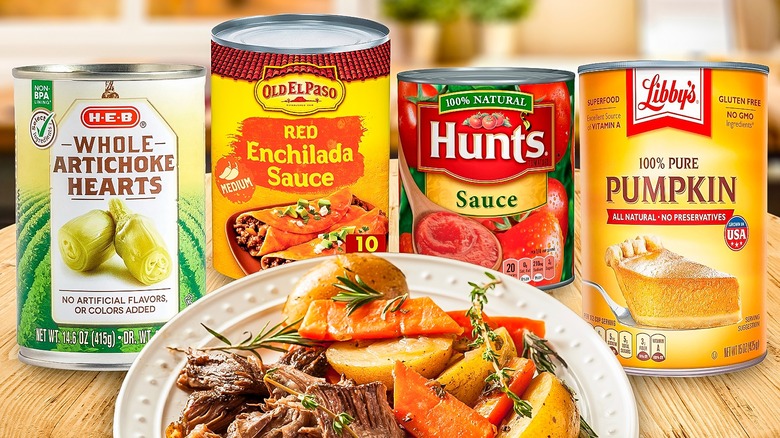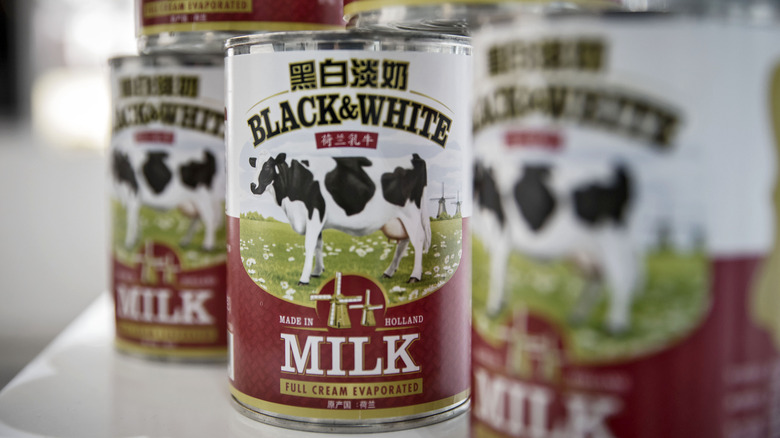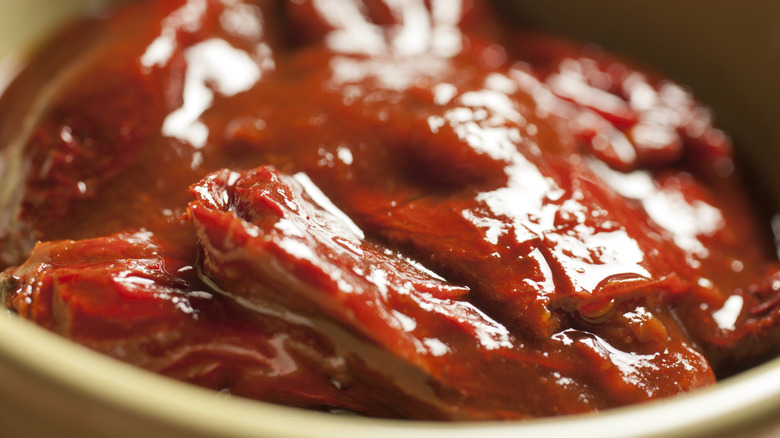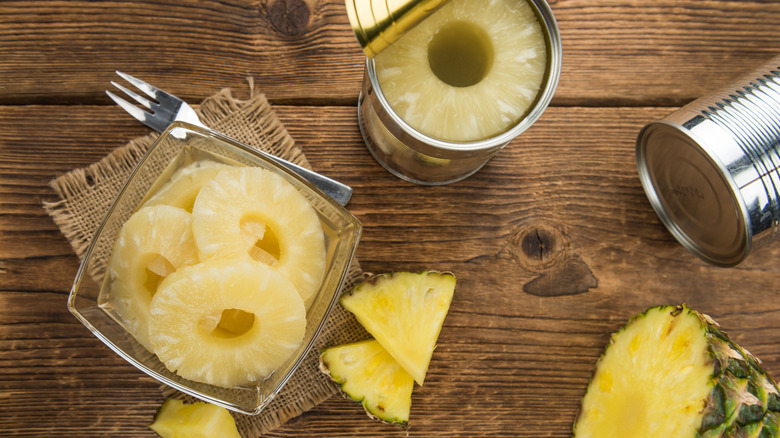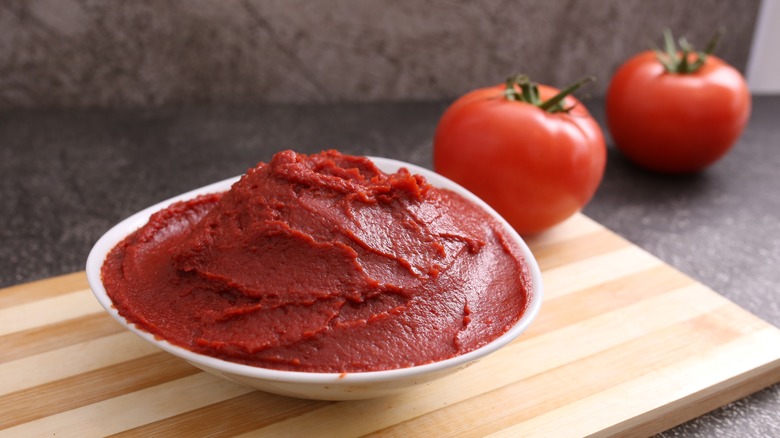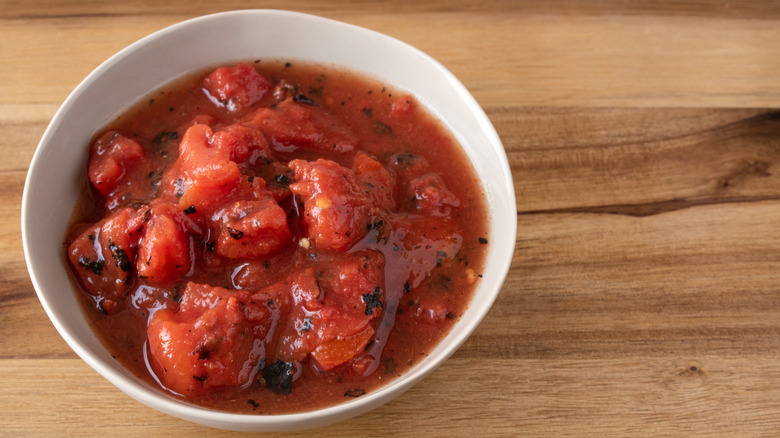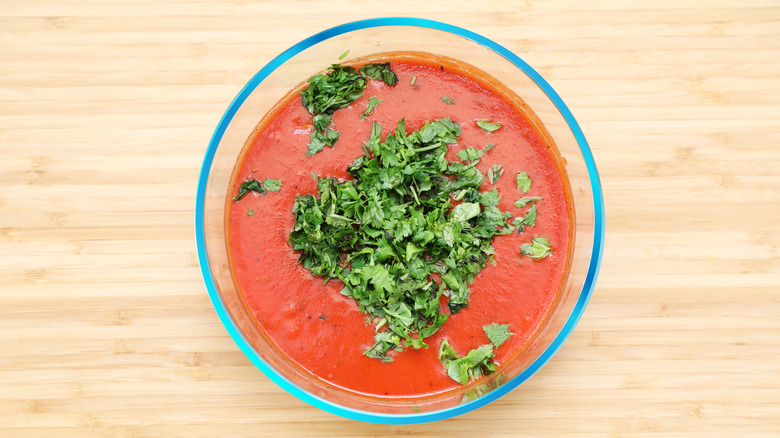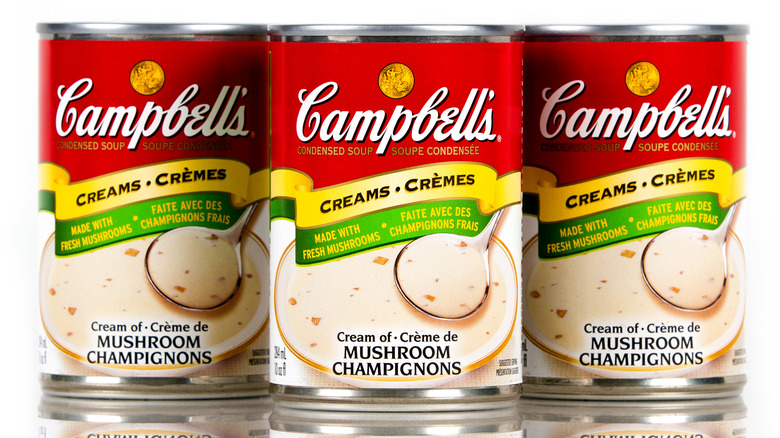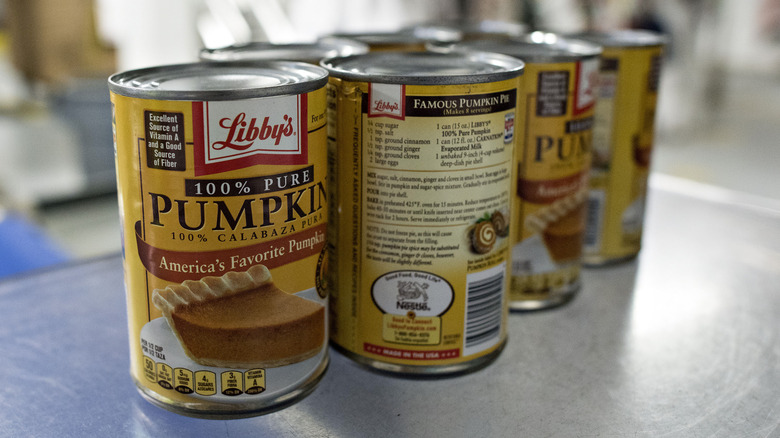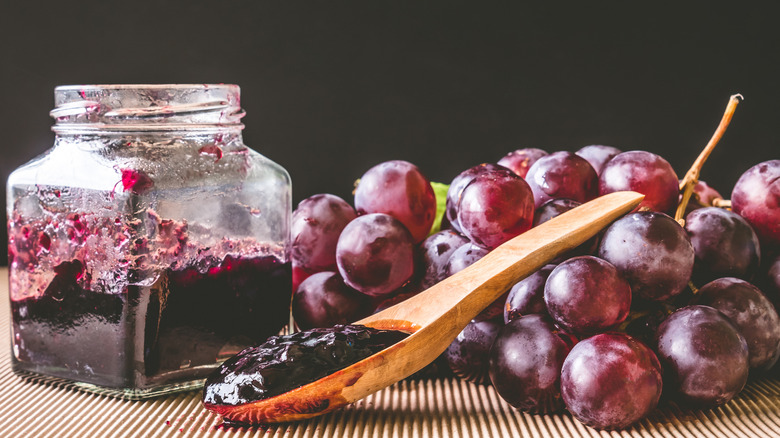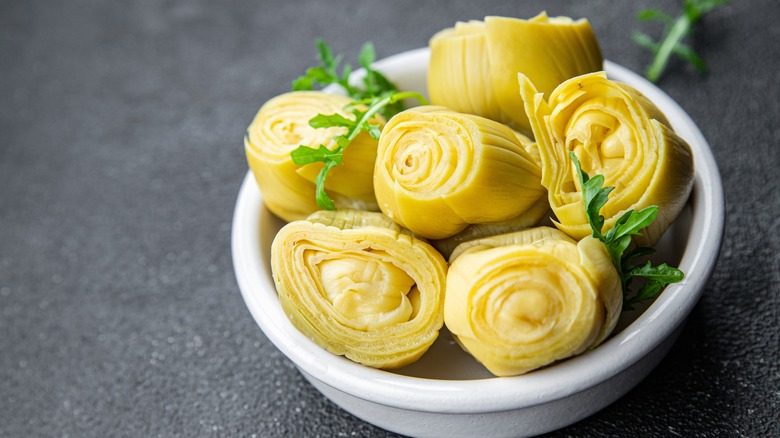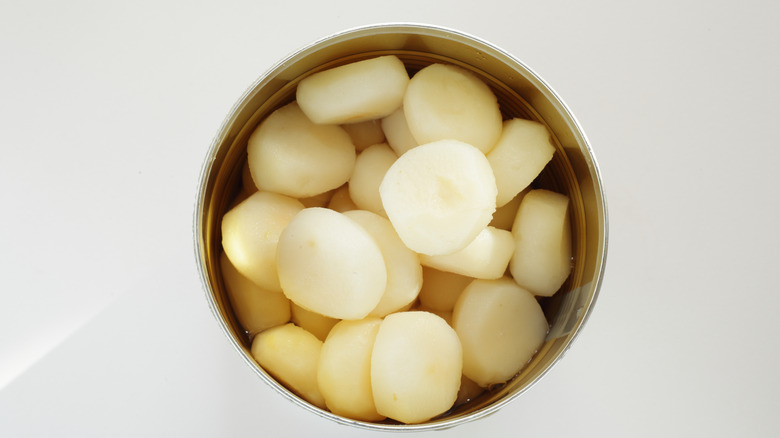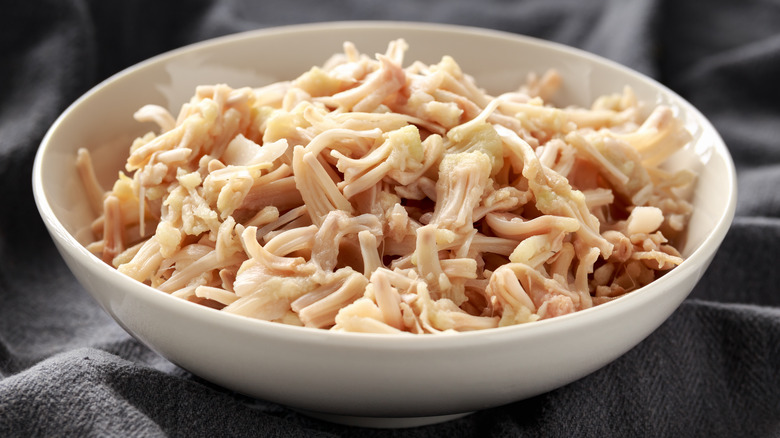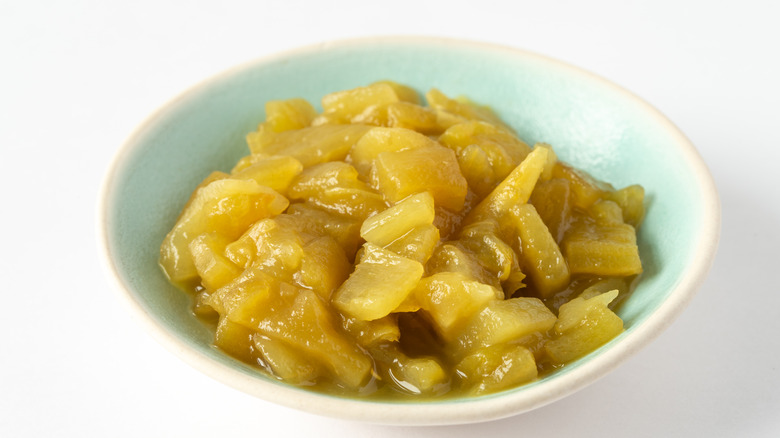13 Canned Ingredients To Elevate Slow Cooker Meals
When it comes to weeknight timesavers, the slow cooker is the unsung hero of the kitchen. The set-it-and-forget-it appliance has been a staple of busy households for decades for its minimal prep and mouthwatering results. From soup to barbecue and even French toast, there's not much this multi-use appliance can't handle.
Of course, there are a few tips and tricks to cooking with a slow cooker. For the ultimate dump-and-go appliance, a programmable model is a must. You'll also want to pre-heat your slow cooker to coax maximum flavor out of your ingredients. And yes, there is a difference between a Crockpot and a slow cooker. But, at the end of the day, what matters most is what you put into the pot.
Soups, stews, and slow-cooked meats are all perfectly delicious one-pot wonders, but sometimes they seem to be missing that extra oomph that comes from cooking on a stovetop or in the oven. Tips like searing meat or sauteeing vegetables in advance can take up precious prep time that not every busy cook has in abundance. Often-overlooked canned goods can provide a wonderfully easy shortcut to maximum slow cooker flavor. Take your next weeknight dinner from bland to bold with minimal effort by adding one of these under-the-radar canned ingredients.
Evaporated milk
Is there anything quite as comforting as returning home from a long day of work to a steaming pot of soup? The classic slow cooker meal, soup tastes best when simmered for hours on end. When it comes to creamy soups like chowders and bisques, making the most of your slow cooker can be a bit more complicated. That rich, velvety texture is typically achieved by adding a splash of heavy cream to a pot bubbling away on the stove. When simmered for a long time in a slow cooker, the rich dairy has the unpleasant tendency to curdle.
Luckily, you can avoid this culinary catastrophe by swapping heavy cream for a can of evaporated milk. By definition, evaporated milk has already been cooked to the point of losing more than half of its water content, which means that the shelf-stable dairy product brings the richness of cream without the temperamental tendency to separate. Just be sure to keep that can of evaporated milk at room temperature before adding it to your slow cooker soup — if the milk is cold, it could still potentially curdle.
Even if you're going dairy-free (or just worried about the milk curdling), you don't have to skip out on rich and creamy slow cooker soups. Try swapping in a can of coconut milk for a vegan alternative with equally indulgent results.
Chipotle peppers in adobo sauce
Who would've thought your slow cooker concoction could achieve a rich depth of flavor with the addition of one simple canned ingredient? Overlooked by many home cooks who may be unfamiliar with the product, canned chipotle peppers in adobo sauce should be part of your flavor arsenal, especially when whipping up a south-of-the-border-inspired slow cooker dish.
Smoky and savory with a touch of warming heat, chipotle peppers packed in adobo sauce are the product of a long culinary journey that comes to you in the form of a grocery store staple shortcut. Fresh jalapeño peppers are smoked, dried, and then rehydrated, producing a plump, juicy pepper that melds beautifully into slow-cooked dishes like soups, stews, and roasts. But the real kicker here is the adobo. This complex sauce hits all the most mouthwatering notes thanks to spicy dried chiles, tart vinegar, sweet tomato paste, savory garlic, and a variety of spices. The smokiness from the chipotles rounds out the sauce nicely, producing a one-stop shop for maximum slow cooker flavor.
So, which dishes would best benefit from the flavorful power of chipotles in adobo? Truthfully, the sky is the culinary limit. The smokiness of the canned ingredient makes it an ideal accompaniment to meats like beef for slow-cooker birria tacos or a mole-inspired sauce for chicken.
Pineapple
Even the best seasoned slow cooker meats can end up on the bland side. Brighten up those dull flavors with a splash of acid in the form of handy canned pineapple. Typically packed at the peak of freshness, shelf-staple canned pineapple is a prime (and cheap) kitchen hack that adds a burst of sweetness without the hassle of shopping for and chopping up a fresh specimen.
One of the most well-known savory recipes to feature pineapple, braised pork for al pastor tacos cooks up wonderfully in the low heat of a slow cooker and benefits immensely from the sweet, acidic punch of the canned produce. As an added bonus, the canning liquid can double as a braising agent for the meat. Cooked low and slow all day, the pork will be juicy and fork-tender just in time for dinner. Tossed in a tortilla or served over rice, slow cooker al pastor with an extra dose of pineapple is a quick and easy way to liven up your next taco night.
Tomato paste
Inexpensive and underutilized, tomato paste deserves a permanent spot in your pantry for its flavor-packed punch. Thanks to its highly concentrated nature, canned tomato paste imbues a deep tomato flavor into almost any slow cooker dish without adding additional liquid.
Before you go throwing just any tomato product into the slow cooker hoping to achieve a similar result, it's important to note the differences between tomato sauce and tomato paste. While tomato sauce certainly has a place in your pantry, its high water content and pre-seasoned nature make it a poor substitute for the pure tomato flavor found in its pasty sibling. Similarly, a can of crushed tomatoes can add a significant amount of unneeded liquid without imbuing much tomatoey taste. Pound for pound (or in this case, tablespoon for tablespoon), tomato paste packs in the most flavor without altering the consistency of your final dish.
The key to unlocking maximum flavor potential from this pantry staple is to cook it briefly in fat before adding it to your slow cooker. Carmelizing the sugars in the concentrated paste releases a deep umami flavor. Try this simple kitchen trick in slow cooker chili, pasta sauce, or even butter chicken to enjoy a mouthwatering epicurean upgrade.
Fire-roasted tomatoes
Due to a reliance on indirect heat, slow cookers themselves don't impart a ton of flavor into the dishes they churn out. Adding aromatics and swapping in ingredients already infused with extra flavor, like a can of fire-roasted tomatoes, can be the key to mouthwatering results.
Simple yet delicious, the aptly named canned good contains ripe tomatoes that have been roasted over an open flame before being diced, packaged, and placed on your local grocery store shelf. This direct contact with the open flame brings smokiness, sweetness, and a touch of char (look for the black flecks that are sometimes still visible on the blistered tomato skin) that can imbue your next batch of chili with comforting fire-roasted flavor.
But it's not just chili that can benefit from an extra dose of smokiness. Try swapping in the fire-roasted variety in any slow cooker recipe that calls for canned tomatoes. Tex-Mex-inspired dishes like chicken tortilla soup are made even more flavorful with the addition of smoky, charred tomatoes without any more effort than operating a can opener.
Enchilada sauce
Spice up cold-weather comfort food with a handy can of store-bought enchilada sauce. A mouthwatering blend of roasted chiles, spices, and stock, the canned sauce adds a well-rounded heat to soups, stews, and braised meats without the hours of prep needed to whip up a homemade batch.
While enchilada sauce straight from the can is perfectly delicious, you can up the flavor ante of your next slow cooker creation with just a few quick tips and tricks. Elevate red enchilada sauce with a dash of adobo sauce from a can of chipotle peppers or freshen up the green variety with an extra dose of garlic. No matter which sauce you choose, adding a squeeze of lime just before serving will be sure to brighten up those smoky flavors.
The simplest dish to liven up with a can of enchilada sauce is a Southwest-inspired soup. Combine chicken, stock, beans, corn, some smoky spices, and a can of enchilada sauce in your slow cooker and let it simmer away over low heat for several hours. Top with a dollop of sour cream and a squeeze of lime for a warm bowl of comfort that's ready to consume the minute you walk through the door.
Cream of mushroom soup
Cream of mushroom soup is a classic slow cooker favorite for a reason. The richness of the concentrated soup blended with the umami blast from the mushrooms results in an indulgent dish that takes minimal effort to prepare.
cream of mushroom soup is a quintessentially American ingredient with a fairly storied history as a kitchen hack. Invented in 1897 by Dr. John T. Dorrance, the condensing process allowed soups to be sold in cans, extending their shelf life in an era before refrigeration was common. Consequently, cream of mushroom came about in 1934 and quickly gained popularity as a staple in Campbell's Test Kitchen recipes of the 1940s and 50s, including Thanksgiving-favorite green bean casserole.
Today, cream of mushroom soup works its magic in many a slow cooker recipe as a sauce or the base for a hearty soup. Simmer in a slow cooker with chicken and vegetables for a riff on chicken pot pie or cook with beef and served over noodles for a shortcut beef stroganoff. No matter which slow cooker dish you choose to whip up with the classic canned soup, you can elevate the flavor even further with a few more store-bought ingredients like Worcestershire sauce to elevate the umami flavor of the mushrooms or freshly ground black pepper and garlic powder for some extra spice.
Pumpkin purée
Give slow cooker staples like chili a seasonal twist with the addition of a can of pumpkin purée. A time-saving alternative to using a whole gourd, pumpkin purée (also known as canned pumpkin) contains cooked and mashed orange squash without any additional flavorings — in other words, the perfect fall flavor booster.
The precise kind of squash found in your can of pumpkin is harder to discern. While cans bearing the label "100% pumpkin" are easily sourced from your local grocery store, these cans might actually contain a blend of gourds, including butternut and other heirloom squash. But this mislabeling isn't such a bad thing. While great for carving, traditional field pumpkins don't bring much to the table in the way of flavor, whereas other orange squashes provide that nostalgic autumnal taste you're likely looking to add to your slow cooker chili.
When choosing the best can of pumpkin purée, you might notice a variation in taste between different brands based on the blend of squashes each recipe uses. No matter which brand you pick, just be sure to reach for pumpkin purée or canned pumpkin and not pumpkin pie filling. The sickly sweet and spiced dessert mixture probably won't mesh well with that simmering pot of savory chili in your slow cooker.
Grape jelly
Take a page out of a vintage cookbook by tossing a jar of jelly into your slow cooker to give meatballs a sweet-and-sour twist. Grape jelly in particular brings the tang and gives your final product a shimmery glazed finish that makes slow cooker meatballs good enough for company.
The cocktail party favorite combo of grape jelly and meatballs has stood the test of time for good reason. Made popular in the 1960s and '70s as a quick and easy appetizer for a crowd, the simple hors d'oeuvre saw a resurgence in the mid-2000s thanks to the growing popularity of the slow cooker as an everyday appliance. Today, the dish remains a popularly nostalgic offering, especially for holiday entertaining. Google Trends data shows a predictable annual spike in searches for "grape jelly meatballs" every December.
The secret to the sweet and tangy dish's longevity is two-fold. Firstly, the simple dish barely needs a recipe: Cocktail-sized meatballs (store-bought or frozen are perfectly fine) are tossed into a slow cooker with equal parts jelly and chili sauce. The mixture is cooked low and slow until that signature shiny glaze forms, and the meatballs are cooked through. Flavorwise, the saccharine grape jelly paired with the warming heat of tomato-based chili sauce makes for a sticky-sweet glaze with a pleasant hit of spice that tantalizes the tastebuds any time of year.
Artichoke hearts
Add a Mediterranean twist (and an extra dose of veggies) to your next slow cooker dish with a simple can of artichoke hearts. The hearty vegetable stands up well to a long simmer over low and slow heat and imparts just enough savory flavor to roasted meats or vegetable-forward stews.
With their seemingly endless layers of spiky petals, fresh artichokes are notoriously difficult to prepare and are, frankly, not worth the effort in everyday cooking applications. While there is certainly a time and a place for fresh produce, canned artichoke hearts are a weekday timesaver that ensures you can squeeze in a little extra nutrition with as much effort as it takes to operate a can opener. According to Healthline, one cup of antioxidant-rich artichoke hearts adds a healthy dose of fiber, vitamin C, and potassium (among other vitamins and minerals) and 5 grams of protein — an impressive amount for a purely plant-based food.
While artichoke hearts can easily be added to any slow cooker dish, their most famous application is likely party-favorite spinach and artichoke dip. Easy enough to whip up in your slow cooker, the cheesy crowd-pleaser can be lightened up with tangy Greek yogurt and fresh rather than frozen spinach so you can enjoy all the mouthwatering flavor.
Water chestnuts
Pleasantly crunchy without adding overbearing flavor, canned water chestnuts are the perfect textural addition to your favorite dips or Asian-inspired slow cooker meals. They may be known for their signature crispness, but the confusingly named water chestnut isn't actually a nut at all. Despite its botanical moniker, the water chestnut is actually a type of aquatic tuber vegetable sourced from the root of a freshwater marsh plant that grows in semitropical climates like Southeast Asia or Florida.
Water chestnuts don't bring much flavor to the party with an extremely mild taste reminiscent of a coconut-apple hybrid. Their redeeming virtue is that satisfying crunch, which means timing is everything when it comes to cooking with the tuber. To get the most bite for your buck, be sure to add canned water chestnuts to your slow cooker in the last few minutes of cooking — ideally about five minutes before serving. The low heat will keep the vegetable from becoming soft too quickly, but you don't want to let it cook for too long or risk losing out on that delightful texture.
Jackfruit
A popular plant-based meat substitute, jackfruit is the perfect vegan alternative for barbecue and carnitas slow-cooker recipes. The imposing produce is the world's largest tree-born fruit, weighing up to 40 pounds. When harvested before it's ripe, the fruit maintains a firm, stringy flesh akin to a mushroom that keeps its form well when cooked. Luckily, you don't need to worry about breaking down the mammoth meat substitute — with the fruit's growing popularity in recent years, it's easy enough to find canned.
As convenient as it is, canned jackfruit still requires a little bit of prep before it's ready for experimentation in the slow cooker. Jackfruit is typically canned in brine in order to preserve freshness, a salty mix you'll want to rinse off before using. You'll also want to chop larger chunks into more manageable pieces — as with any recipe, it's best to keep everything about the same size to ensure even cooking.
Now that your canned jackfruit is prepped, it's time to get cooking. Thanks to its stringy texture, the produce is the perfect meatless substitute for pork in your favorite slow cooker recipes. Similarly to tofu or tempeh, jackfruit is a flavor sponge that soaks up just about any sauce you want to throw on top. Try it piled high on a bun in a meatless jackfruit barbecue sandwich or packed into tortillas for a vegan twist on tacos.
Green chiles
Looking for a simple way to add a bit of kick to otherwise bland slow cooker meals? Try adding a can of green chiles straight from the pantry. From chicken chili to potato soup, green chiles are the key to unlocking deliciously spicy flavor in your next slow cooker recipe.
While green chiles may be a familiar ingredient to those who love to add heat to just about everything their tongue touches, the spice-averse have nothing to fear from the humble canned good. Every chile releases a compound called capsaicin, which our tastebuds perceive as heat. These levels are measured on the Scoville scale. For comparison, the more commonly consumed habanero sits at a tolerable 100,000 to 350,000 units.When it comes to the humble "green chile," the most common types of pepper used in the canned product are milder varieties like Anaheim, Poblano, and Pasilla. These chiles rate much lower on the Scoville scale at roughly 1,000 to 2,500 units.
Considering that the humble jalapeño weighs in at around 6,000 units, even the mildest palates can enjoy the warming heat that canned green chiles bring to the table. So, don't be afraid to toss a few into your next batch of slow cooker chili for a little warming heat.
